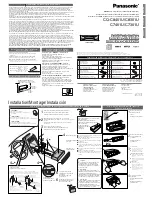
8
user manual LokSound / LokSoundXL V3, 1st edition, 07/2004
3.1.4 Connecting the speaker
LokSound decoders may only be used with the
speakers supplied by ESU electronic solutions ulm
GmbH & Co. KG. They have an impedance of 100
Ohm. The use of speakers by others may cause
considerable distortion and in extreme cases even
destroy the LokSound decoder.
The correct position of the speaker is crucial to achieve
high quality sound. A speaker that is installed without
a resonance chamber will not generate good sound.
Therefore carefully select the location and sound
chamber for the speaker.
The speaker must be installed in such a way that the
sound waves are not unduly blocked.
Please handle speakers with extreme care: don’t
apply pressure or touch the membrane! The
speaker’s magnets are very powerful! Keep all
metal items away and secure the speaker firmly
when soldering. The soldering iron may pull the
speaker due the magnetic field and destroy it.
Connect the speaker to the 2
dark brown wires of the
LokSound module. Make sure
that you use a small soldering
iron (max. 20 W) and only heat
the marked spots as shown in
the figure (close to the edge
of the small contact plate).
Polarity is not important
An optimal sound effect is achieved by putting the
speaker into a sound chamber, which is supplied with
the speaker. This will increase the sound pressure and
channel the sound in one direction. Without sound
chamber the sound effect may be unsatisfactory. Feed
the speaker wires through a small hole in the sound
chamber.
Connecting the speaker / auxiliary function devices / wheel sensor
3.1.5 Connecting auxiliary function devices
Any load may be connected to the lighting and
auxiliary function outputs as long as it doesn’t exceed
the maximum current (see technical data in the
appendix of this manual). Note that the overload
protection of the decoder reacts quickly and will switch
off all functions immediately in case of an overload or
short circuit.
Therefore use only 16 V lamps (or a higher
voltage) and a maximum nominal current of
50mA: incandescent lamps have a high starting
current and may trigger the overload protection
during switch-on.
Use only digital smoke generators (e.g. Seuthe No.
11) for engines whose lighting and auxiliary function
outputs are connected as shown in figure 2. Other
smoke generators draw too much current. There are
smoke generators with more than 250mA nominal
current on the market!
Engines that are wired as shown in figure 3 need an
analogue smoke generator e.g. Seuthe No. 10.
Make sure that the total current for the function
outputs does not exceed the permitted current
rating and avoid short circuits between outputs.
Although the output circuits are protected, a
high voltage on the terminals or a short circuit
may cause damage.
3.1.6 Connecting a wheel sensor
To synchronize the exhaust chuffs with the revs of
the drivers an external sensor can be (but does not
have to be) used. The sensor input is described in
figure 6.
LokSound decoders support reed contacts or
mechanical contacts.
If a reed contact is to be used a miniature magnet
(available at hobby shops) must be attached to the
driving wheel axle in such a way that the magnet
releases the reed contact once every turn. Miniature
reed contacts have been proven to be very reliable.
They are available at electronic specialist stores.
Suitable magnets may be bought at model train shops.
(e.g. Mini-track magnets) which might have to be
shaped to fit.
speaker
chamber
solder here!









































